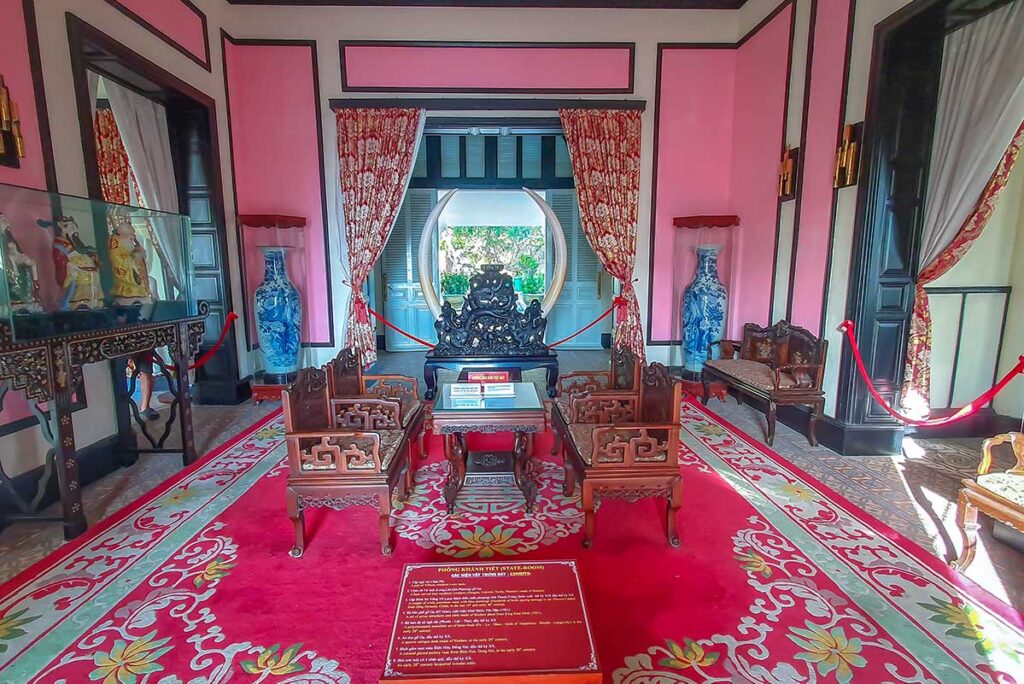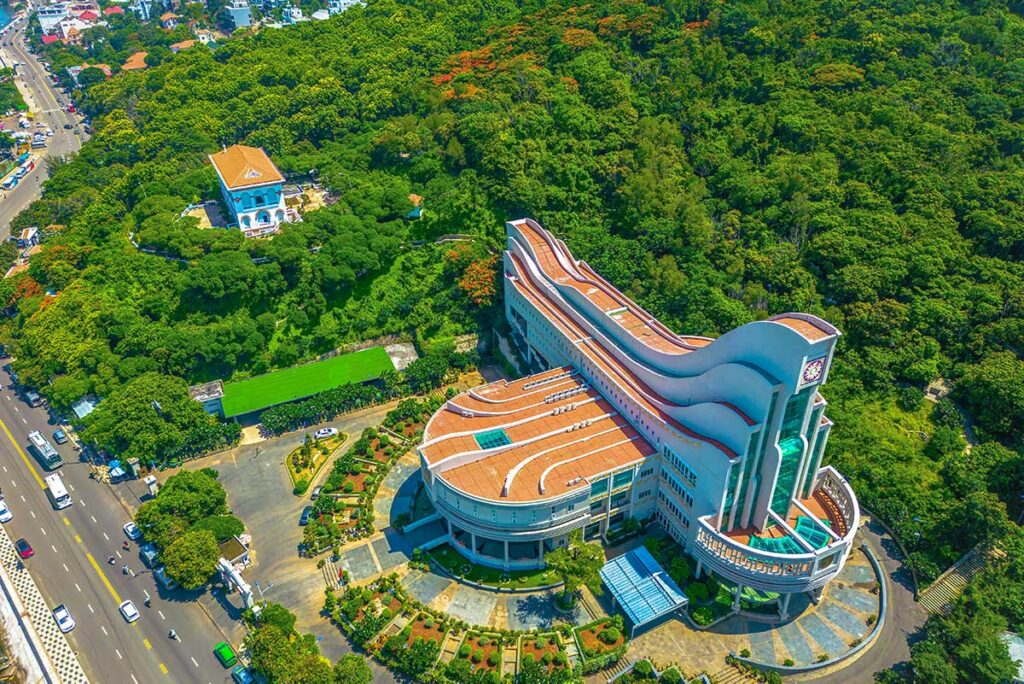What is Bach Dinh (White Palace)?
Bach Dinh, better known to foreigners as the White Palace or by its French name Villa Blanche, is a colonial-era villa on the slopes of Big Mountain in Vung Tau. From its hillside location between Front Beach and Mulberry Beach, the mansion looks out over the coastline and the busy road below.

The three-story building, painted bright white with a red-tiled roof, is a blend of French and Greek-inspired architecture. Today it functions as a small museum, displaying antiques and artifacts alongside well-preserved interiors.
For most travelers, the White Palace is not a destination to spend hours at, but it makes for an interesting cultural stop with a dose of history, a look inside a colonial residence, and sweeping sea views.
History of the White Palace
Construction and French Colonial Era
The White Palace was built between 1898 and 1902 during the French colonial period. Its French name, Villa Blanche, was linked to Governor-General Paul Doumer, who oversaw its construction before returning to France, where he later became President. Designed as a summer retreat for colonial officials, the villa combined European architectural styles with its striking white façade and commanding position on Big Mountain.
Role in Vietnamese History
Beyond its colonial past, the villa also played a part in Vietnam’s own history. King Thanh Thai, known for his opposition to French rule, was confined here under house arrest from 1907 until 1916. Later, the villa was used as a residence and retreat by Emperor Bao Dai, the last emperor of Vietnam, as well as by presidents of the Republic of Vietnam in the mid-20th century. These layers of history give the palace more depth than just being an old French mansion.
Recognition as National Historical Relic
In 1992, the White Palace was officially recognized as a national historical and cultural relic. Today, it serves as both a museum and a reminder of the complex mix of colonial influence and Vietnamese history in Vung Tau. While not the grandest heritage site in Vietnam, it remains one of the city’s most notable landmarks.
Things to See at the White Palace
1. Exterior & Architecture

The first impression of the White Palace is its bright white façade and red-tiled roof, a clear nod to late 19th-century French and Greek architectural styles. Decorative details include colorful ceramic mosaics of peacocks, flowers, and carp, as well as eight Greek-style busts of European figures set into the walls. The balconies and arched windows are photogenic, and the garden outside is dotted with frangipani trees that add a tropical touch to the colonial design.
2. Interior & Rooms

Inside, the villa gives a glimpse of colonial life with tiled floors, wooden staircases, and a number of preserved rooms furnished in period style. Bedrooms and sitting rooms still carry traces of their former elegance. While parts of the interior show signs of age and could use more maintenance, it adds to the feeling of stepping back in time rather than into a polished museum.
3. Artifacts & Antiques Collection

The small museum inside the villa showcases a mix of royal Vietnamese and colonial-era artifacts. Highlights include Nguyen dynasty furniture, large porcelain vases decorated with phoenixes, statues of Phuc – Loc – Tho (Happiness, Prosperity, Longevity), and a pair of African ivory tusks. One of the most interesting displays is a collection of ceramics recovered from 17th-century shipwrecks near Con Dao, which adds a maritime twist to the visit. In the garden, you’ll also find old cannons that once defended Vung Tau from the Nguyen dynasty’s Phuoc Thang fortress.
4. Views & Terraces

Even if you’re not a history enthusiast, the views from the palace are worth the visit. The terraces look down over Front Beach, the winding coastal road, and across to Small Mountain where the giant Christ statue stands. The sea breeze makes it pleasant to linger here, and the best times for photos are early morning or late afternoon when the light softens.
5. Pavilion & Grounds


Beyond the main building, the grounds are a pleasant area to walk. A small octagonal pavilion (bat giac) sits on the slope, offering another shady resting spot. Visitors can reach the palace by walking up a stairway of 146 steps lined with frangipani trees, or by following a road shaded by tall teak trees. Either way, the approach is as enjoyable as the site itself and adds to the experience.
Vung Tau Museum (Next Door)

Right next to the White Palace is the Vung Tau Museum, housed in another colonial-era building. The museum covers local history with a mix of exhibits ranging from traditional artifacts and ceramics to a large private weapon collection.

It’s not a must-see compared to the White Palace itself, but if you already made the climb up the hill and have extra time, it can be a worthwhile add-on. A quick visit gives more context to the history of the area and pairs naturally with a stop at Bach Dinh.
Practical visiting information
Address & Location
The White Palace is located at 4 Tran Phu Street, Vung Tau, on the slope of Big Mountain (Núi Lớn). From here it overlooks Front Beach and the coastal road, making it easy to combine with other nearby sights.
Opening Hours
The site is usually open daily from 7:30 – 11:30 and again from 13:30 – 17:30. The grounds may remain accessible outside these hours, but entry to the building itself follows this schedule.
Entrance Fee
Tickets cost around VND 15,000 per person. Parking is extra: about VND 10,000 for motorbikes and VND 30,000–50,000 for cars.
Visiting tips
- Avoid peak times: Weekends and public holidays draw big crowds. For a quieter visit, go on a weekday morning.
- Beat the heat: Midday can be hot, so early or late in the day is more comfortable.
- Dress modestly: Shoulders and knees covered are advisable, as this is a recognized cultural site.
- Stay practical: Bring water, sunscreen, and a hat—there is little shade on the terraces.
- Time needed: Around 30 to 60 minutes is enough to see the building, exhibits, and enjoy the views.
How to get there
By Taxi or Grab
The simplest way to reach the White Palace is by taxi or Grab from anywhere in Vung Tau. From hotels near the beaches or the city center, the ride only takes a few minutes and drops you directly at the entrance.
By motorbike
Many foreign visitors rent a scooter to get around Vung Tau, and the White Palace is an easy stop along the scenic coastal road. The ride is pleasant and lets you combine the visit with other attractions like the lighthouse or Christ statue. Officially, you should have an international driver’s license and valid insurance, even though rental shops rarely ask for it. If you are comfortable riding, it’s one of the nicest ways to explore the city.
Walking
If you’re staying near Front Beach, the White Palace is close enough to walk. A stairway with 146 steps, shaded by frangipani trees, leads up the slope to the villa. It’s a short but steep climb, so bring water and take your time, but the views and shady path make it a rewarding approach.
Nearby sights to combine With
The White Palace doesn’t take long to visit, so it’s easy to combine with other attractions in the area. A few nearby highlights include:
- Front Beach (Bai Truoc) – Right below the palace, this central beach is good for a stroll in the evening or to relax with a drink by the waterfront.
- Vung Tau Lighthouse – Built by the French in 1862, the lighthouse offers 360° views of the peninsula and both beaches.
- Christ of Vung Tau Statue – A 32-meter-high statue on Small Mountain, one of the city’s most iconic landmarks.
- Nghinh Phong Cape – Rocky cliffs with strong sea winds and a natural “sky gate,” popular for photos.
- Worldwide Arms Museum – A surprisingly large private collection of weapons and military uniforms from around the world.
- Local temples – Scattered around Vung Tau, these make a quieter cultural stop if you’re interested in Vietnamese spirituality.
- Coastal road – The drive between Front and Back Beach is one of Vung Tau’s most scenic stretches, perfect to combine with a motorbike ride.
For a full list of options, see our guide to the best things to do in Vung Tau.



